How to Deal With Cat Constipation?
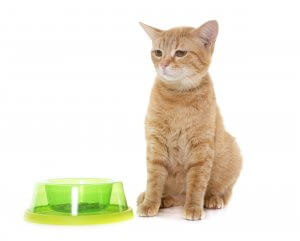
Like humans, cats also have constipation. Constipation is less frequent than normal and difficult to pass stools. There can be many causes of constipation: they can be behavioral, result from dietary errors, and can also be a symptom of other health problems. In the article below you will learn what causes the cat’s constipation and how to help a pet with this inconvenience.
Best Food for Constipated Cat
Hill’s Prescription Diet w/d Feline Chicken
A low-fat and high-fibre food recommended for cats with an obesity tendency to maintain optimal weight and for cats with diabetes mellitus.
Key Benefits: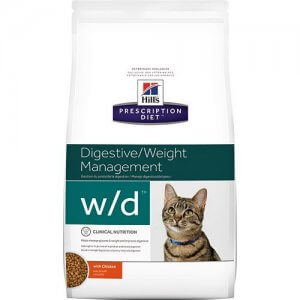
- Low fat and calories to help your cat maintain its ideal weight.
- High in fibre to help reduce the feeling of hunger and avoid pedigree behaviour.
- Supplemented with L-carnitine to help burn fat and maintain muscle mass.
- High in fibre to help regulate bowel movements.
- It helps neutralize free radicals thanks to its high levels of antioxidants.
- With a delicious flavour and available both dry and wet to adapt to the preferences of each cat
Feeding Guide:
| For weight loss | For weight maintenance | |
|---|---|---|
| Ideal body weight kg | Grams of dry food | Grams of dry food |
| 2 | 30 – 45 | 35 – 50 |
| 3 | 40 – 60 | 50 – 70 |
| 4 | 50 – 70 | 60 – 85 |
| 5 | 60 – 85 | 75 – 100 |
| 6 | 70 – 100 | 85 – 115 |
| 7+ | 13 per kg | 16 per kg |
High-quality protein and carefully selected ingredients. COMPOSITION: Cereals, meat and animal by-products, plant protein extracts, by-products of vegetable origin, oils and fats, mineral substances. Carbohydrate sources: Corn, beer rice.
3193 kcal / kg (319 kcal / 100g)
| Nutrient | Dry matter % |
|---|---|
| Protein | 39.4 |
| Fat | 9.5 |
| Gross fibre | 8.9 |
| Carbohydrates (ELN) | 35.7 |
| Calcium | 1.07 |
| Phosphorus | 0.86 |
| Sodium | 0.31 |
| Potassium | 0.83 |
| Magnesium | 0.081 mg |
| Taurine | 0.20 |
| L-carnitine | 501.9 ppm |
| Vitamin C | 110 ppm |
| Vitamin E | 596 IU / kg |
| Omega-3 fatty acids | 0.19 |
| Omega-6 fatty acids | 2.57 |
Prescription Diet i/d Feline Stew with Chicken and Vegetables
The digestive health of your cat can be affected for different reasons, and when this happens, it can be an unpleasant experience for everyone involved. The good news is that you can help your cat feel better with a food formulated to provide the digestive care he needs.
Hill’s veterinarians and nutritionists have developed Prescription Diet i/d, nutrition specially formulated to help improve the digestion and quality of cat faeces.
A stew of sandwiches carefully cooked with chicken and vegetables added, with a delicious flavour, which will help you strengthen the bond with your pet.
How does it work:
-
- Highly digestible with optimal fibre balance
- Prebiotic fibre and omega-3 and omega-6 fatty acids
- High in group B electrolytes and vitamins
- Clinically proven antioxidants
- Promotes the regularity of bowel movement
- Supports the maintenance of a healthy balance of intestinal bacteria
- It replenishes the loss of nutrients and promotes easy absorption of them
- Promotes the maintenance of a healthy immune system
Additional Information:
Hill’s Prescription Diet i/d is a complete dietary food that provides all the nutrition with your cat needs. Check with your veterinarian for more information about how Prescription Diet foods can help your cat continue to enjoy a happy and active life.
To get better results:
- Cover and refrigerate the unused quantity
- Make the transition to the new food for at least seven days, or follow the veterinarian’s recommendation
- It is recommended to administer only Prescription Diet foods, both wet and dry
- Always keep fresh and clean water at your disposal
- Consult with the veterinarian to control the pet’s body condition
Feeding guide:
| Bodyweight (kg) | Cans 82g |
|---|---|
| 2 | 1 4/5 |
| 3 | 2 1/2 |
| 4 | 3 |
| 5 | 3 2/3 |
| 6+ | 2/3 per kg |
Guide for mixed feeding:
| Bodyweight (kg) | Cans 82g | Grams of dry food |
|---|---|---|
| 2 | 1 | 15 |
| 3 | 1 | 30 |
| 4 | 1 | 40 |
| 5 | 1 | 50 |
| 6+ | 1 | 10 per kg |
Prescription Diet i/d Feline Stew is a complete dietary food for the reduction of acute intestinal absorption disorders and the compensation of digestion disorders and exocrine pancreatic insufficiency in the cat. This dietary food has higher electrolyte content, very digestible ingredients and low-fat content.
High quality protein and carefully selected ingredients. COMPOSITION: Meat and animal by-products, by-products of vegetable origin, extracts of vegetable proteins, cereals, oils and fats, vegetables, mineral substances, seeds. Highly digestible ingredients: Chicken, pork liver, rice flour, rice starch, rice.
78 kcal / 2.9 oz (82 g) can
| Nutrient | Dry matter % |
|---|---|
| Protein | 37.9 |
| Fat | 23.2 |
| Gross fibre | 2.7 |
| Carbohydrates (ELN) | 29.4 |
| Calcium | 1.09 |
| Phosphorus | 0.87 |
| Sodium | 0.49 |
| Potassium | 0.94 |
| Magnesium | 0.087 mg |
| Taurine | 0.46 |
| L-carnitine | 25.5 ppm |
| Vitamin C | 145 ppm |
| Vitamin E | 602 IU / kg |
| Omega-3 fatty acids | 0.33 |
| Omega-6 fatty acids | 3.93 |
Hill’s Prescription Diet i/d Feline with Chicken
Prescription Diet Feline i/d Tender Snacks in Chicken Sauce is a highly digestible formula developed specifically to help control the gastrointestinal problems of cats. For the nutritional management of cats with gastrointestinal disorders and cats in recovery.
Key Benefits: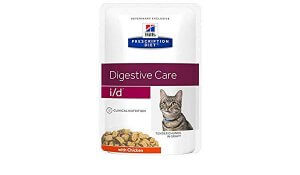
-
- It helps neutralize free radicals thanks to its high antioxidant content.
- With a delicious flavour that you will love and available in dry and wet so that your cat enjoys even more with the mixture or combination of both formats
Guide for mixed feeding:
| Bodyweight (kg) | Bags of 85g | Grams of dry food |
|---|---|---|
| 2 | 1 | 15 |
| 3 | 1 | 30 |
| 4 | 1 | 40 |
| 5 | 1 | 50 |
| 6 | 1 | 60 |
| 7+ | 1 | 10 per kg |
Feeding guide:
| Body weight (kg) | 85 g sachets |
|---|---|
| 2 | 1 2/3 – 2 1/4 |
| 3 | 2 1/4 – 3 |
| 4 | 2 3/4 – 3 3/4 |
| 5 | 3 1/4 – 4 1/2 |
| 6 | 3 3/4 – 5 |
| 7+ | 2/3 per kg |
Prescription Diet i/d Feline is a complete dietary food for the reduction of acute intestinal absorption disorders and for the compensation of digestion disorders and exocrine pancreatic insufficiency in cats. This dietary food has higher electrolyte content, very digestible ingredients and low-fat content.
High-quality protein and carefully selected ingredients. COMPOSITION: Meat and animal by-products (chicken 25%), by-products of vegetable origin, fish and fish by-products, eggs and egg products, sugars, cereals, vegetable protein extracts, mineral substances, oils and fats, yeasts. Highly digestible ingredients: Chicken, pork, salmon, wheat flour, pea protein, dried egg.
| Nutrient | Dry matter % |
|---|---|
| Protein | 38 |
| Fat | 20.2 |
| Gross fibre | 2.6 |
| Carbohydrates (ELN) | 32 |
| Calcium | 1.03 |
| Phosphorus | 0.92 |
| Sodium | 0.48 |
| Potassium | 0.95 |
| Magnesium | 0.084 mg |
| Taurine | 0.24 |
| L-carnitine | 25.5 ppm |
| Vitamin C | 87 ppm |
| Vitamin E | 754 IU / kg |
| Vitamin A | 77109 IU/kg |
| Vitamin D | 1239 IU/kg |
Hill’s Prescription Diet z/d Feline
An elimination diet to detect food allergies in cats and for long-term nutritional management.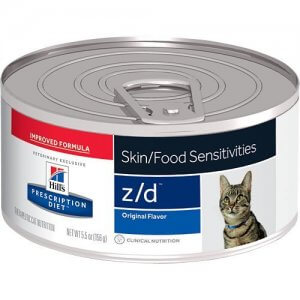
Key Benefits:
-
- It helps nourish the skin and hair thanks to its formula with high levels of essential fatty acids
- It helps neutralize free radicals thanks to its high level of antioxidants
- It has a delicious flavour that facilitates its combination with dry food so that your cat enjoys more each meal
- Consult with your veterinarian for more information and advice on the most appropriate feeding for your cat
Guide for mixed feeding:
| Bodyweight (kg) | Cans 156g | Grams of dry food |
|---|---|---|
| 2 | 1/2 | 15 |
| 3 | 1/2 | 20 |
| 4 | 1 | 30 |
| 5 | 1 | 30 |
| 6 | 1 | 40 |
| 7+ | 1 | 8 per kg |
Feeding guide:
| Bodyweight (kg) | Cans 156 g |
|---|---|
| 2 | 3/4 |
| 3 | 1 |
| 4 | 1 1/3 |
| 5 | 1 2/3 |
| 6 | 1 3/4 |
| 7+ | 1/3 per kg |
Prescription Diet z/d Feline is a complete dietary food for reducing ingredient and nutrient intolerance in adult cats. This dietary food contains a selected source of carbohydrates and a selected source of highly hydrolyzed protein.
High-quality protein and carefully selected ingredients. COMPOSITION: Meat and animal by-products, by-products of plant origin, mineral substances, oils and fats. Carbohydrate source: Corn starch. Protein source: Hydrolyzed chicken liver.
174 (156g can)
| Nutrient | Dry matter % |
|---|---|
| Protein | 34.3 |
| Fat | 17.7 |
| Gross fibre | 1.6 |
| Carbohydrates (ELN) | 40.6 |
| Calcium | 0.67 |
| Phosphorus | 0.67 |
| Sodium | 0.32 |
| Potassium | 0.93 |
| Magnesium | 0.058 mg |
| Taurine | 0.37 |
| L-carnitine | 35.3 ppm |
| Vitamin C | 339 ppm |
| Vitamin E | 1046 IU / kg |
| Vitamin A | 105413 IU/kg |
| Vitamin D | 571 IU/kg |
Cat food Feed Royal Canin Fiber Response Feline
Royal Canin Fiber Response is a complete and last-generation dietary food, indicated for the treatment of acute or chronic constipation of adult cats. Enriched with soluble fibres and psyllium, this feed facilitates intestinal transit and promotes softer stools in animals that suffer from illness, slow transportation or colonic discomfort.
In fun croquettes, this veterinary prescription cat food combines a series of nutrients: high digestibility proteins, prebiotics-EPA / DHA (fructooligosaccharides and mannan oligosaccharides), chicory pulp, rice and fish oil, to offer your pet a maximum Protection of your digestive system.
The synergistic antioxidant complex (vitamin E, vitamin C, taurine and lutein) helps preserve cellular DNA, promotes immune system health and fights free radicals, whose negative effects increase with age. Also, the S / O index prevents the formation of stones and crystals of struvite and calcium oxalate.
Advantages: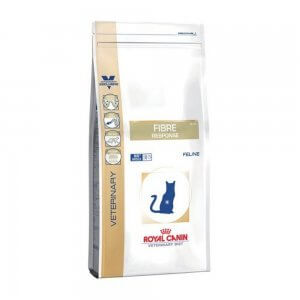
-
- Cat food that facilitates intestinal transit
- Its formulation contributes to maximum digestive safety
- The synergistic antioxidant complex strengthens the immune system
- Prevents the formation of stones and struvite crystals
Use and specifications:
-
- Feed of croquettes for adult cats with acute and chronic constipation
- It is not indicated for cases of obstipation and megacolon
- This is a veterinary prescription feed. For proper use, we advise you to consult any questions with your usual veterinarian or with us through the section “Veterinary consultations”
- Supply this product to your pet in case of acute constipation for 3 or 4 weeks when it is first presented. For recurring cases, Fiber Response Feline can be used in the long term
- Make sure your cat has free access to fresh, clean water
Nutritional Description:
Ingredients: dehydrated poultry proteins, rice, corn, wheat gluten *, animal fats, corn gluten, psyllium seeds and integuments, animal protein hydrolyzate, chicory pulp, minerals, dehydrated egg, fish oil, yeasts, oil of soy, fructooligosaccharides, yeast hydrolyzate (source of mannan-oligosaccharides), Indian rose extract (source of lutein).
Analytical composition: crude protein 31%, crude oils and fats 15%, crude ash 7.9%, crude fibres 2.9%, EPA and DHA fatty acids 3.2 g / kg. L.I.P .: protein selected for its high assimilation.
Nutritional additives (per kg): vitamin A 22000 IU, vitamin D3 800 IU, E1 (iron) 39 mg, E2 (iodine) 3 mg, E4 (copper) 7 mg, E5 (manganese) 51 mg, E6 (zinc) 168 mg, E8 (selenium) 0.07 mg, preservatives, antioxidants.
Dosage:
Recommended daily amounts in grams (g):
| Cat weight | Slim | Normal | Overweight |
|---|---|---|---|
| 2 kg | 39 g | 33 g | |
| 3 kg | 52 g | 44 g | |
| 4 kg | 64 g | 54 g | 43 g |
| 5 kg | 75 g | 63 g | 50 g |
| 6 kg | 86 g | 71 g | 57 g |
| 7 kg | 95 g | 80 g | 64 g |
| 8 kg | 105 g | 88 g | 70 g |
| 9 kg | 114 g | 95 g | 76 g |
| 10 kg | 123 g | 103 g | 82 g |
What can be the reasons for a cat’s constipation?
At the beginning it is worth determining how often cats should defecate, because it looks different in different species of animals, which people often do not realize. In the case of healthy, healthy cats eating good-quality food (wet, well-balanced and meat), the bowel movement occurs once a day or once every two days. The stool is hard, rather dry and odorless or almost odorless.
In cats on the BARF diet (Biologically Appropriate Raw Food), i.e. a properly composed and balanced mixture of raw meat, offal and meat bones with supplements, one bowel movement for two or three days is the norm. Stool with this diet has a similar, or even more compact texture and is usually completely odorless.
So the problem starts if, first of all:
-
- When cleaning the litter box, we notice that these norms have been exceeded, and secondly, the cat expresses his behavior that he has trouble passing faeces
- The animal may tell us this in various ways, but certainly any pain, blood or mucus present in the feces or defecation outside the litter box should worry us
In the case of a poop found outside of the litter box, let’s not stress the animal with shouting or scolding – he did not do it maliciously. It may also happen that the cat will enter the litter box and try to defecate, but he will not succeed. So where do these cuvette problems come from?
Ingestion of indigestible items
First of all, cats often consume indigestible objects and materials that lead to intestinal obstruction and thus constipation. Such items are most often all kinds of pieces of fabric, strings, ribbons from gifts, fishing rods and other toys, plastic small parts, plants. If you notice that the cat has just eaten such an object, or if we already see its end from the anus side, you should not try to help the animal yourself.
By pulling such a string or ribbon, you can only damage the intestines. Surgical intervention at the vet may be necessary, especially if the foreign body is long, has a sharp edge, or if you notice severe pain or blood. If the cat is behaving normally and the object consumed was small, we can contact the veterinarian by phone and follow his instructions.
Inadequate diet
Cat’s constipation also often occurs through hair accumulated in the intestines, or rather – licked fur, commonly known as “fluff”. Usually to the so-called confusion occurs when a cat is on an inappropriate diet and its digestive system is not able to get rid of the hair collected in it. If the diet is sufficiently moist and fatty, cats are unlikely to have such problems. It is worth planting grass especially for the cat, which it will be able to gnaw. It will help him get rid of his hair.
For cats whose carers prepare meals themselves or animals that are fed, constipation may occur due to too many bones in the diet. Of course, bones are a very important element of the menu and should be in it (only in raw form and always with meat, never bare bones), but it is very important to maintain the right proportions with the other ingredients.
Behavioral causes
Behavioral causes related to cat constipation are mainly associated with the litter box itself. The first thing to look out for is the cleanliness of the litter box. Many cats do not empty into a dirty toilet. In addition, you must remember that cats are animals that love routine, repeatability, which is why stress caused by changes, such as a new animal, new household member, moving house, renovation – can cause cat constipation or, conversely, diarrhea.
Health factors
Cat constipation caused by health factors is primarily due to obstruction or weakening of the colon. Obstruction of the colon can be caused by pseudoprostasis, rectal repositioning (called perineal hernia), disorders located in the intestinal lumen (tumor, granuloma, scarring, foreign body in the rectum, congenital narrowing) or outside the intestinal lumen (also tumor and granuloma, but also granuloma) , combined pelvic fracture, prostatic hyperplasia, prostate or periglandular cyst, enlargement of lumbar lymph nodes).
Weakness of the colon can be caused by some general disease, for example hypercalcaemia, hypokalemia, hyperthyroidism or Chagas disease. It also happens that it results from local neuromuscular damage, such as spinal cord injury, pelvic nerve damage, dysautonomy or chronic, massive dilatation of the colon causing irreversible stretching of its muscular tissue. A cat may refuse to defecate if it is unable to take the right position, and this may be due to orthopedic or neurological problems.
Drug action
Cat constipation can also be caused by iatrogenic factors, i.e. those that are the result of medical treatment and actions. Here, attention is drawn to drugs such as opiates (psychoactive substances), sucralfate (gastric mucosa), barite (a means used as contrast in imaging diagnostics) or anticholinergic drugs. Another reason for constipation may be severe dehydration.
How do you diagnose constipation?
The veterinarian will certainly interview the cat’s guardian. In an interview he will try to find iatrogenic, dietary, environmental and behavioral causes. Vet may carry out stool and rectal examination. Serum biochemistry or ultrasound may be required. Colonoscopy is also an indication if the cause was not palpable.
How can you help a cat with constipation?
Depending on the cause of constipation, you can help your cat in different ways. Usually, the first step is to give paraffin oil, which will facilitate bowel movements. However, you should either give it to a veterinarian or an experienced person, because it is easy to let the cat choke with oil. Rectal ingot and removal of residual fecal masses may be necessary.
In the case of diet errors, you should analyze the balance of homemade meals, including the proportion of bone in the diet.
In the case of a tame cat, it will be helpful to plant grass that he can chew, or to add a bit of animal fat to the food – for example butter or lard (without salt, onions, greaves or other!).
If the kitten does not deal with behavioral reasons, find the source of the problem and eliminate it. The cat must always have access to the litter box. The cuvette should be of the right dimensions so that the cat can fit in and turn there easily; best discovered. The location of the litter box can also be a problem – if the cat is not completely interested in it, let’s find a different corner in the house for her. It is also practical to have an additional litter box for cats who are reluctant to use even a slightly soiled toilet.
If it turns out that the cat’s constipation is caused by stress, he should be given peace and comfort. It is worth taking care of the game while maintaining hunting behavior, proper diet, psychophysical fatigue of the cat and routine every day (e.g. meals at the same hours). In addition, you can use preparations with tryptophan, which works gently silencing, or cat pheromones in the form of a pheromone collar or in a diffuser connected to the socket. In case of health problems, you will need to have appropriate treatment or even surgical intervention.

